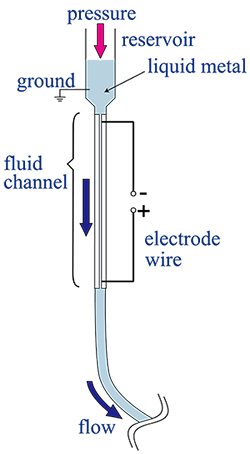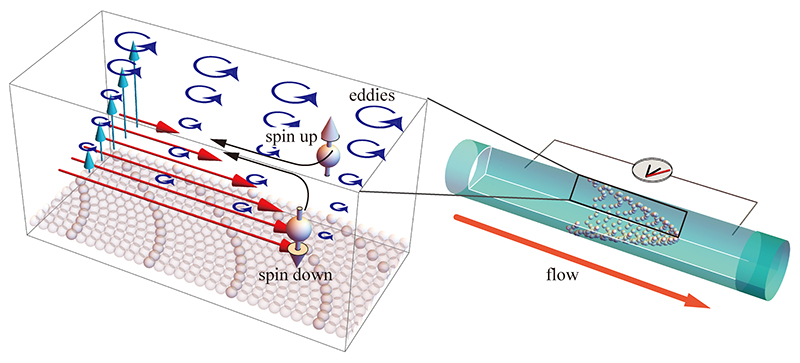Manipulating electron spins in a liquid metal marks an important first step in 'fluid spintronics'
Simply pumping mercury through a thin pipe can generate a small voltage, due to an unusual effect demonstrated for the first time by Tohoku University researchers1.
The work can be applied to build small power generators, and -- perhaps more importantly -- it opens a new way to leverage the tiny rotation of electrons known as spin toward the emergence of 'spinmechanics'.
Spin gives electrons an intrinsic magnetism that can point either up or down, like a tiny bar magnet. In recent years, researchers have found several ways to manipulate spin in solid materials. But relatively little is known about their behavior in liquid metal, or how spins are affected by the mechanical rotation of the material around them.
A team from the Institute for Materials Research, led by Ryo Takahashi and Eiji Saitoh, has now tackled both of these questions, kick-starting the study of fluid spintronics.

A liquid metal such as mercury generates a small voltage when it flows through a narrow channel.
Ⓒ Takahashi, R. et al.
The team passed mercury through a narrow quartz pipe, and used platinum wire electrodes at each end of the pipe to measure any voltage. Swirling eddies in the mercury near the pipe's walls cause spin-up electrons to drift toward one side of the pipe, and spin-down electrons to the opposite side. The surrounding mercury atoms then bend the moving electrons' trajectories, a phenomenon known as the inverse spin Hall effect. This causes the electrons to move in a direction opposite to the flow of mercury, creating a voltage as more electrons accumulate at one end of the pipe.
In a quartz tube 80 millimeters long and 0.4 millimeters wide, a flow of 2.7 meters per second generated 50 nanovolts. The voltage could be further increased by using faster flows, or a longer or narrower pipe.

Caption: Eddies in flowing mercury pull spin-up and spin-down electrons to opposite sides of the pipe, while the inverse spin Hall effect pushes them upstream.
Ⓒ Takahashi, R. et al.
Another liquid metal -- an alloy of the lighter gallium, indium and tin -- gave slightly lower voltages under matching conditions, which the team attributes to a weaker interaction between electron spin and electron motion expected from these lighter metal atoms.
"The system might be useful as an electric generator for some nanomechanical devices," says Takahashi. It could also provide a source of electrons all spinning in the same direction, potentially useful in spintronics. "The observed phenomena will bridge the gap between spintronics and hydrodynamics, and will become a stepping-stone to expand spintronic phenomena into fluids."
Flexing certain solids might cause structural distortions that deflect electrons in a similar way, something which the researchers hope to observe. They also plan to study the inverse effect, by using a flow of electron spins to move a fluid.
- Reference:
1. Takahashi, R. et al. Spin hydrodynamic generation. Nature Physics 12, 52-56 (2016).
DOI: 10.1038/nphys3526
Contact:
Tohoku University
Tel: +81-22-217-6238
Email:eizi@imr.tohoku.ac.jp

